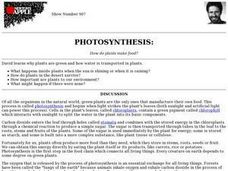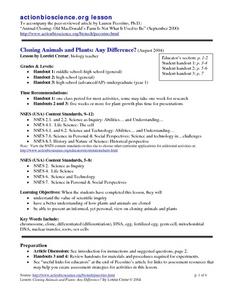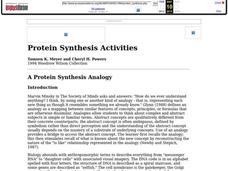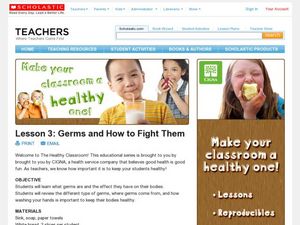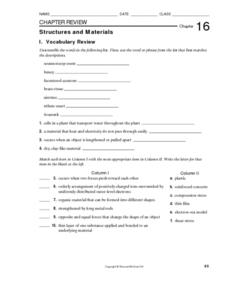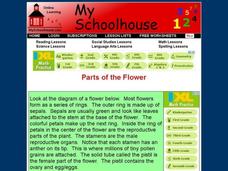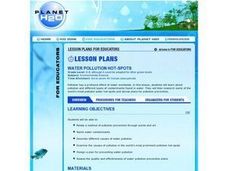Curated OER
Photosynthesis: How do plants make food?
Learners study why plants are green and how water is transported in them. They examine how plants respond to different amounts of light.
Curated OER
Reproduction of Animals and Plants Crossword Puzzle
In this crossword puzzle, students answer 27 clues about vocabulary terms related to the reproduction of both animals and plants.
Curated OER
Reproduction of Animals and Plants Crossword Puzzle Answers
In this crossword puzzle instructional activity, students are given the answers to 18 clues about vocabulary related to the reproduction of animals and plants.
Curated OER
Cloning Animals and Plants: Any Difference?
Students examine the process in which plants and animals are cloned. They compare and contrast the two procedures and determine if there is a difference. They share their views on cloning to the class.
Curated OER
Protein Synthesis Activities
Pupils compare the process of protein synthesis in an analogy. They simulate the process of protein synthesis kinesthetically using index cards and write a paragraph to explain the process.
Curated OER
THE FARMER CARES FOR THE LAND
Students will identify cause and effect relationships in issues relating to Agriculture and the environment.Ask students to describe what farmers do. Then ask students to define the word "environmentalist." Ask students if they have...
Curated OER
Germs and How to Fight Them
Students learn how important it is to stay healthy. In this germ lesson plan, student learn what germs are and the effect they have on healthy bodies and explore how important it is to keep their bodies healthy through a classroom...
Curated OER
Milkweed Monitoring
Ninth graders study milkweed and see how it is effected by ozone. In this air pollution lesson students complete a lab activity that includes data analysis.
Curated OER
Analogies
In this analogies worksheet, students complete the analogies about fuel, carbon dioxide, decay, and more. Students complete 10 analogies.
Curated OER
Land Associations
Middle schoolers identify and explore life forms of various biomes, define transitional regions, examine effects of abiotic and biotic interactions, research a biome, and produce newspaper that features environmental information. Lessons...
Curated OER
Living and Non-Living
Fourth graders are divided into small groups and collect 4 objects from the playground. They take 5 to 10 minutes to classify their groups and discuss their findings including the terms "living" and "non-living". As a class they discuss...
Curated OER
Genetics
Students explain the difference between dominant and recessive genes, identify what causes differences in the traits of parents and their offspring, and explain how sex is determined. They will also improve their reading and...
Curated OER
Structures and Materials
In this materials worksheet, learners will review different types of materials and the structures that can be made using these materials. This worksheet has 7 fill in the blank, 6 matching, 1 short answer, and 6 multiple choice questions.
Curated OER
Collecting Plankton
In this science worksheet, students learn facts about plankton by reading two pages of factual information. Students read about the different kinds of plankton and how it is classified. Detailed drawings are included. There are no...
Curated OER
Alive or Not
For this organism worksheet, learners review the characteristics that determine if something is alive or not. This worksheet has 5 fill in the blank and 7 matching questions.
Curated OER
Woodland Math Facts
In this Woodland math facts worksheet, students study and examine woodland weights of trees and shrubs, explore invertebrates and draw a bar chart to chart their findings.
Curated OER
Parts of the Flower
For this biology worksheet, students examine a diagram of a flower and read a selection that describes all of the parts including the petals, the stamen, the anther, and the sepals. They answer 11 on-line fill in the blank questions...
Curated OER
How Much Energy is a Kilowatt Hour?
Students study the conservation of energy. In this energy instructional activity students explain the differences between potential and kinetic energy.
Curated OER
Fungus Among Us- Non-Fiction Reading Comprehension Worksheet
In this fungus non-fiction reading comprehension worksheet, students read a 3 page selection that describes the characteristics and life of fungi. They answer 10 questions based on the reading which include true or false, multiple...
Curated OER
Spelling Dictation Sentences
In this spelling sentences activity, 5th graders practice spelling these dictation sentences for 2 sentences every week. Students spell a total of 72 sentences.
Curated OER
Water Pollution Hot-Spots
Students complete internet research in small groups to identify types of water pollution, spotlight water pollution hot-spots, and design a plan for water prevention.
Curated OER
Production Methods
Pupils examine the different methods of production. They relate the new concepts to different production contexts. They identify the external factors that influence firms.
Curated OER
The Long Road to Coffee
Students organize picture cards of the sequene of how food gets from a farm to their home. They then sequence cards of how coffee grown in Colombia gets to their home comparing the differences.
Curated OER
Fossil Impressions of Ancient Life
Students make a mold using Plaster of Paris and then make a cast using that same mold. They pick a fossil and describe how it looks. They write a fictionalized story about its life, or burial. (
Other popular searches
- Plant Cell Biology
- Plant Cell Diagram
- Animal and Plant Cells
- Plant Cell Illustrations
- Specialized Plant Cells
- Animal Cells Plant Cells
- Plant Cell Structure
- Plant Cell Parts
- Animals and Plant Cells
- Animal & Plant Cells
- Compare Plant Animal Cells
- Animal Plant Cells
